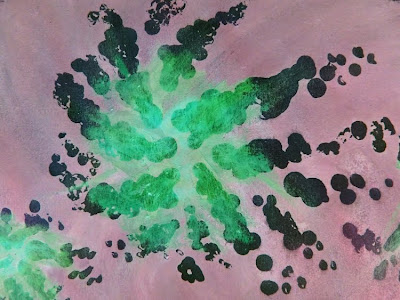As part of my UWA I have been annotating images. My annotations have now progressed to form paragraphs! Albeit small paragraphs, but hey ho - got to start some where. I am currently studying the early Renaissance, and here is my first text...
 Giotto - The Lamentation of Christ c. 1305 (fresco)
Giotto - The Lamentation of Christ c. 1305 (fresco)
Scrovegni (Arena) Chapel, Padua, Italy
The fresco image is split in to two halves. On the bottom half you have Christ's body being held and surrounded by mourners. In the top half you have ten angels in the sky. In the top right corner, there is a lone tree on a rocky ridge, this moves down the painting to led you to where Christ's head is being cradled by the Virgin Mary. It is clear that Christ's body has just been taken down from the cross, yet this is not shown in the picture.
The arrangement of people in the scene is unusual, as the closest figures are two men with their backs facing the viewer. These help to indicate that Christ is encircled, people overlap and the image is not flat. A sense of depth is created in the picture, similar to that of a theatre stage. Religious figures are indicated by their halos. A crowd of mourners are cut from the frame on the left. All the characters display grief and sorrow, through their different facial expressions and their posture. It is said that Giotto visited funerals to watch people as they mourn.
Christ's body is being held above the ground by the mourners. This could be interpreted that his body had weight, like that of a mortal; or that his body is soon to be resurrected. His face is cradled by his mother Mary, similar to images of her cradling him as a child. Each person is individual, and you are able to tell who they are, for example Mary Magdalene is shown with red hair, touching his feet and John the Baptist is shown outstretching his arms in anguish. Light falls down on Christ's body, and highlighting John's robes.
The lone tree is bare of leaves, which could indicate death. Though as trees renew their leaves in spring, it could indicate the resurrection and eternal life. The tree could also be the the garden of Eden, where sin was first committed, and that Christ then dies for our sins. The bleakness of the background contrasts with the richness of the robes, the array of colours, and the detail of folds indicating the body shapes underneath. The angels are all painted with different postures and show foreshortening.
The Lamentation is an important piece of art, it moved pictures from being flat images, to those that create a sense of depth. Giotto draws the viewers eye to the bottom left of the picture (in contrast to the more traditional centre of a piece) by use of the mountain ridge line and the characters arrangement. The individual expressions of both the people on earth and the angels, highlight the real sense of emotion and anguish of the piece.
 Whistler - Red and Black: The Fan 1891-94 (oil on canvas)
Whistler - Red and Black: The Fan 1891-94 (oil on canvas)
































